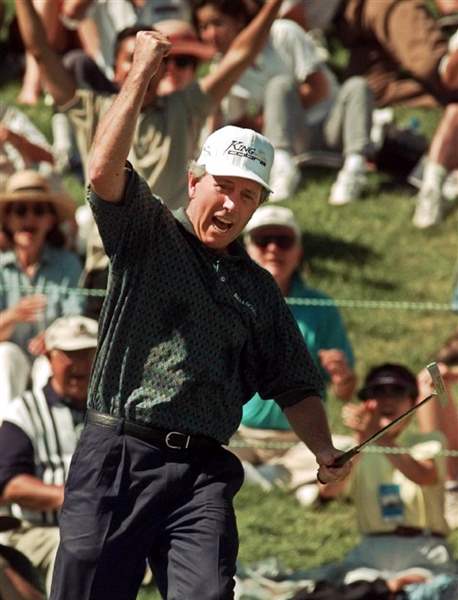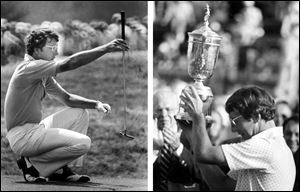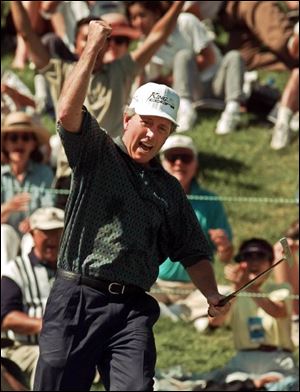
U.S. SENIOR OPEN
Open season at any age for Irwin
Veteran has won U.S. and U.S. Senior titles
7/24/2011
Hale Irwin sinks a putt at No. 18 to win the 1998 U.S. Senior Open at Riviera Country Club in Los Angeles. He also won the title in 2000.
Associated Press

Hale Irwin lines up a putt at the ninth green at Inverness Club in the final round of the 1979 U.S. Open and later held up the championship trophy, the second of three U.S. Open crowns he won.
He has won three U.S. Open championships and two U.S. Senior Open titles. He is the only active professional golfer to have won both.
He is the most successful player in Champions Tour history with 45 wins -- next best is 29 -- including seven senior majors.
He has a combined 65 victories and $31.5 million in official earnings between careers on the PGA Tour and Champions Tour.
How many names have you come up with so far?
OK, one more hint, which should give it away.
His three U.S. Open victories came at Winged Foot, the most sadistic USGA layout of all time in 1974; at Inverness Club in 1979, and at Medinah in '90, when he made a 45-foot putt on the 72nd hole to force a 19-hole Monday playoff at the end of which he became the oldest Open champion ever.
"Looking back at all those special moments sort of makes it even more fleeting," said Hale Irwin, who turned 66 last month. "I'm older. I know I'm not the player I was, but I still think I'm capable. It's a game of ebbs and flows, though. The last several years, I've been in the doldrums."
Irwin, whose last victory came in 2007, hopes to turn back the clock this week as he returns to Inverness for the U.S. Senior Open.
"When we played the Senior Open there in 2003 I had to withdraw because I'd hurt my back," Irwin said. "I was very saddened by that because I'd been pointing my game for Inverness. So I'm really looking forward to going back. The fact I've won there will give me some reason for optimism, even though it has been a long time."
It has been 32 years and Irwin was then among the game's best, especially in big tournaments on tough courses. And it all started with the biggest and toughest at Winged Foot. A year earlier, Johnny Miller had shot a startling final-round 63 during the Open at Oakmont and the USGA wasn't about to let such a thing happen the following summer.
"Yes, I think Winged Foot in '74 was the exclamation point on difficulty," Irwin said. "More recently, the greens got away one year at Shinnecock and Bethpage was brutally long, but during my [PGA Tour] career, Winged Foot was the epitome of pushing the envelope to the limit."
He won what was dubbed "The Massacre at Winged Foot" with a 7-over-par 287 total after hitting a memorable 2-iron shot to inside 20 feet on the final hole. The top-10 finishers included Arnold Palmer, Tom Watson, Gary Player and Jack Nicklaus.
A 2-iron shot had a lot to do with his '79 win at Inverness, too. Irwin took control on the par-5 13th hole during the third round when he hit a shot from 225 yards to within three feet for eagle.

Hale Irwin sinks a putt at No. 18 to win the 1998 U.S. Senior Open at Riviera Country Club in Los Angeles. He also won the title in 2000.
From 1975-78, Irwin compiled what is now the fourth longest streak in PGA Tour history with 86 consecutive cuts made. Only Byron Nelson, Nicklaus and Tiger Woods are ahead of him on that list.
"I played some great golf from the mid-to-late 1970s," Irwin said. "I wouldn't say Inverness was the end of things, but it was a cap to a great run. From a career perspective, winning another Open meant I wasn't a one-and-out. It put me back in the major championship picture."
By 1990, though, Irwin was pretty much out of that picture when he arrived at Medinah, where two days of rain turned the longest Open course, to that date, even longer. He was tied for 20th after 54 holes and all he thought about walking to the 11th tee on Sunday was that "if I played 1-under from there, I'd probably get in the Open again the next year without having to qualify."
So he birdied four straight holes and then made the dramatic birdie putt on the 18th green to tie Mike Donald and force a playoff.
"I was fortunate in my career to hit some great shots at the most opportune times," Irwin said.
In addition to those three Open victories, Irwin won tour events at Muirfield Village, Pebble Beach and Harbour Town, and added Senior Open titles at Riviera and Saucon Valley.
What made him such a horse for tough courses?
"Well, I guess it's partly my background in athletics. As a college football player (at Colorado) I was never the most blessed in size or speed. There were so many guys I played with and against who were as good or better. But I think I had the desire to excel; the heart.
"When I started as a tour golfer, my goodness, I realized there were players with huge talents that had played for much longer than I had. So I had to approach it with the same attitude. I had to try harder and find a way to make my game work.
"That's what I took with me onto those great courses that you face during a U.S. Open. I had to learn a way to beat them. The rough is up, the fairways are narrow, the greens are small and firm. I always drove it relatively straight, which was a factor at Inverness. I was a good iron player, which was a key with the small greens there. I was a consistent putter.
"I'd say I wasn't outstanding at anything, but I wasn't deficient at anything. I believed in myself and I always tried to be as good as I could be."
And Irwin turned out to be one of the best, even if you may have had trouble identifying him at the start of this story.